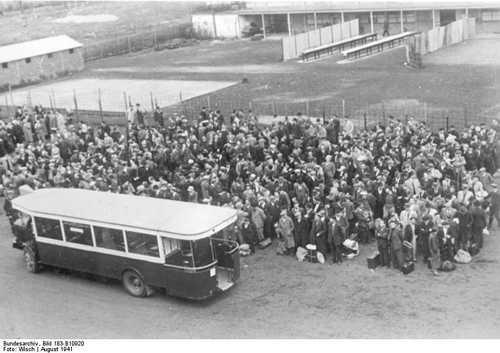
German Forces
One-way journey.
Bundesarchiv.
Jewish citizens of Paris prepare to board buses at Drancy transit detention camp, Paris, August, 1941. The buses would take them to a nearby railway station or other railhead, where they would be entrained for "resettlement" in the East. Drancy, based in a prewar "model" apartment complex, was chosen as a site for the transit camp not least because of its accessibility to the excellent Paris railway system, which is particularly densely represented in this, the St Denis area of north-east Paris. In the initial period following the Occupation, the Germans were sensitive to possible French objections to little oddities like the Reich's Jewish policies. By mid-1941, however, they were coming to a better understanding of the Vichy régime and its willingness to do business with the Germans, not to mention the anti-Semitism common in some classes of French society. France had, of course, a long-established, fully assimilated Jewish community, as well as more recent groups of well-established, wealthy Jews. Neither of these were immune from French anti-Semitism. However, the group most exposed were less prosperous Jews - small tradesmen, clerks and labourers in the main - who had arrived from Russia, Poland and the Baltic late in the 19th century, settling heavily in Paris. These people were the first to pass through Drancy. In the end, as Vichy yielded more ground, no Jew in France was safe from being arrested (often by French police) and handed over to the SD. Transports ran from Drancy up to the very end of the German occupation of Paris. In sadness, JR.
2495 Views
11/6/2015
